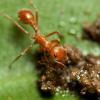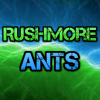I assumed these were Stigmatomma Pallipes due to their slightly tinted silky pupae, but their mandibles weren't elongate enough along with the disapproval of the server Stigmatomma expert. Hence why I put in centipedes, which didn't harm the workers thankfully.
1. Lakeside County, San Diego.
2. Collected 5-17-20
3. Collected in Riparian habitat.
4. ~3 mm
5. Velvety gaster, entirely black,
6. Ponerine gaster, overall very slender. Have a body similar to L. Humile, other discounting the gaster and that they have a stinger(have witnessed them take down a prey with stingers). Pupae are silken, silk is a light beige. Mandibles stereotypically dicondylic, and rather short.
7. Colony was extremely shallow. Was able to dig entire colony with 5 inches with a garden shovel. I say colony, but the queen is either inconsipicuously worker-like, or isn't there, it'd be hard to tell which one is the queen if the former is true since there's about 50-60 workers in the colony. Pupae were exposed as soon as I flipped the rock I found them under, and they still are since I dumped them in one of dspdrew's old dirt box models. Even in the "dirt box" formicarium, the ants never dug deeper than a centimeter. There were surprisingly much less larvae and eggs than pupae. Workers move very slowly; was able to aspirate basically every worker when I clumsily dropped the colony on the floor. They don't try to climb any surfaces they're in, even when exposed to light, instead constantly move larvae and pupae into piles like they were before. They haven't bothered to place a majority of the pupae in underground chambers, but some select pupae were organized and placed in groups of 5-15 in different underground chambers within the formicarium dirt, very shallowly, hints at possible reproductive caste?
8. Colony found right under a rock. No mound, literally a shallow underground chamber. Pupae cramped in piles at the surface before collection.
9. N/A
10. Pictures of ants below after collection. No habitat pictures were taken.
Oh yeah, when identified, I'd like to know about their care and stuff. Of course I'll do my research, but hearing personal experience is also really cool.
(blurry pics, sorry)
https://share.icloud...dVhFWWGBkvKi5eA
https://share.icloud...UWNjYD3RVk3AKXQ
https://share.icloud...BO8cYCY42oKGTkg
















